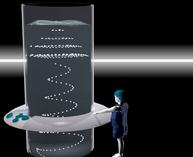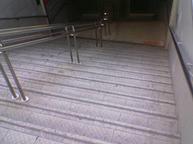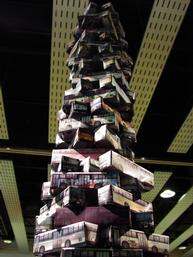FESTIVALPROGRAMM BLOG
AUSZÜGE IN DEUTSCHSIMPLICITY - the art of complexity - ARS ELECTRONICA 2006 - Festival für Kunst, Technologie und Gesellschaft - Linz, Do 31. August – Di 5. September
24
May
Prix Ars Electronica | posted by MariaHieslmayr | at 15:00:00
New technology for displaying information
 © Himanshu Khatri
© Himanshu Khatri
The jury awarded [the next idea] Art and Technology Grant this year to Himanshu Khatri, a 23-year-old artist from the National Institute of Design in Paldi, Ahmedabad, India. The €7,500 stipend will enable him to realize his “Aquaplay” project.
The jurors explained their choice in these terms: “‘Aquaplay’ is an ambitious application for displays that’s based on air bubbles rising through a special fluid. This technology constitutes a completely novel idea and a dramatic contrast to pixel graphics.”
Air bubbles replace pixels
The project plan calls for a large fluid-filled container with air vents in its base. The user is provided with a touchpad to transmit information to the container’s built-in computer about which forms the user would like to depict. The processor uses this information to generate commands to the vents, which in turn give off precisely controlled groups of air bubbles that form the prescribed patterns or blocks of text in 2D or 3D. Diffused lighting turns Aquaplay into a “magical installation.”
This innovative development can be used for information depiction purposes in displays of all kinds as well as for signage and guidance systems or even as a part of an exquisitely designed interior. During the time leading up to the Ars Electronica Festival, the grant recipient will continue to work on the realization of the project at the Ars Electronica FutureLab.
Aquaplay
Himanshu Khatri (IN) / NID - National Institute of Design - Paldi - Ahmedabad - INDIA
24
May
Prix Ars Electronica | posted by MariaHieslmayr | at 13:15:00
The Golden Nica in the Digital Communities category goes to.... canal*ACCESSIBLE
 © canal*ACCESSIBLE
© canal*ACCESSIBLE
How can new media be harnessed to improve the world we live in? Since the introduction of the Digital Communities category in 2004, Prix Ars Electronica has been dealing more intensively with the socially relevant implementation of artistic and technological innovations.
For a barrier-free Barcelona!
As its name suggests, canal*ACCESSIBLE confronts the City of Barcelona’s accessibility—or lack thereof—for handicapped men and women.
40 people who are themselves confined to wheelchairs document the hurdles they encounter on their way through the city via photos made with their cell phone cameras and, in some cases, audio recordings. This material is posted online, and the places at which they were created are specified on a city map. These locations can then be viewed using a built-in “find” function.
A map of Barcelona from a very different point of view
The result is a very special map of Barcelona: namely, a cartographic representation of the parts of town in which barrier-free design is sorely lacking and which are therefore off-limits to people confined to wheelchairs.
3,336 architectural impediments have been documented in this way on canal*ACCESSIBLE since December 2005—thus, empowerment of disadvantaged segments of the population as something other than empty phrases for once.
Whoever’s interested in seeing for themselves the hurdles that the handicapped face in Barcelona can do so online at www.zexe.net/barcelona .
http://www.zexe.net/barcelona (ES)
canal*ACCESSIBLE
Credits: Konzept und Projektleitung: Antoni Abad / Programmierung: Eugenio Tisselli / Organisation: Mery Cuesta / Organisationsassistenz: Pilar Cruz
24
May
Prix Ars Electronica | posted by MariaHieslmayr | at 10:00:00
What do road movies and origami have in common?
 © exonemo
© exonemo
Not a thing, unless you’re talking about the “MobLab” project in which young Japanese and German artists undertook joint adventures in art and communication during a bus trip through Japan. Then, the answer is: quite a bit!
During their journey, this group of artists created a mobile installation entitled “The Road Movie.”
While the passengers were cruising through a wide variety of landscapes, the webcam mounted on the bus produced five images of the surroundings every five minutes. The image files were uploaded to the Internet in the form of a piece of origami art.
If you can’t make the trip to Japan...
Anyone who wants to can print out this origami and create his own road movie with folded busses. Far-off locations are suddenly to be found right in your own living room. Just click onwww.exonemo.com/RM and you’re on your way!
This blend of traditional origami and the road movie film genre within the framework of a very unique Web project won over the jury and was awarded the Golden Nica in the Net Vision category.
The Road Movie
exonemo (JP)
Blog Autoren:
Maria Hieslmayr Cornelia Sulzbacher Wolfgang Bednarzek Gerda Hinterreiter Didi Offenhuber Beta Lounge Artists Sonja Meller StWSt denCity.net
Suche:
Kategorien:
Conferences Animation Festival Events, Concerts & Performances Campus Exhibitions e-lobby Prix Ars Electronica
Recent Posts:
Photographs of the 2006 Festival Media lab thanks! Ars Electronica Center FM4 Live from Ars Electronica in Linz
Archiv:
Posts 180 - 160 Posts 160 - 140 Posts 140 - 120 Posts 120 - 100 Posts 100 - 80 Posts 80 - 60 Posts 60 - 40 Posts 40 - 20 Posts 20 - 0


